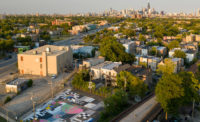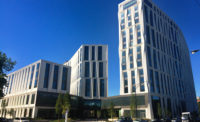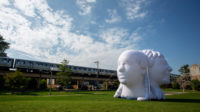Chicago’s 606, the nation’s second elevated rails-to-trails park, will open June 6, and its designers and client have taken pains to ensure that it’s a unique expression of the Second City, not just to be compared to New York’s High Line. In form, function, and funding, the 606’s evolution has taken a different path.
“The High Line is a bridge with a garden on it,” said Matthew Urbanski, of Michael Van Valkenburgh Associates, the project’s lead designers. “This is a landscape.”
Located on the former route of the derelict Bloomingdale industrial freight line and developed by the national non-profit the Trust for Public Land, the park stretches 2.7 miles through Chicago’s Bucktown, Wicker Park, Logan Square, and Humboldt Park neighborhoods on a one-story concrete embankment.
The pedestrian and bike paths on the trail slope up and down, meandering from one side of the embankment to the other, for a more pastoral plan than the industrial High Line. Many of the 606’s ground-level access points are public parks that gradually rise to meet the trail, which is as tall as 17 feet in places.
Visitors aren’t above the neighborhood so much as they’re embedded in it; at some points, the edge of the trail is even connected to adjacent buildings. Urbanski was careful to reveal the rough-hewn craftsmanship of the original embankment: for some sections where the trail drops downward, his team at MVVA removed infill to uncover concrete walls with indentations from the boards that formed it 100 years ago.
“It’s got a kind of industrial honesty to it,” he said. “It’s very Chicago.”
So much industrial brawn is on display, Urbanski says, that he is anxious for the rest of the landscape’s plantings to be installed to balance it out. At a media preview on Tuesday, no herbaceous (annual or perennial) plants have been installed and bald dirt mounds await sod, but the decision was made to let the city to enjoy the park during blizzard-prone Chicago’s savored summer. “Over the summer and into the fall you’ll see the final plantings,” said Beth White, Chicago regional director for the Trust for Public Land. Densely wooded trails filled with young saplings to the side of the main trail will provide seclusion from cyclists and joggers zipping from one end of the park to the other.
Bicycles (which are not allowed on the High Line) are a key component of the 606’s design and funding. A Federal Highway Administration program provided $50 million of its $95 million price tag. The Congestion Mitigation and Air Quality (CMAQ) fund is used for projects that reduce traffic congestion and air pollution. This amount dwarfs city and county contributions ($5 million) and private donations ($40 million), and means that the 606 is essentially funded as a piece of transit infrastructure, unlike the High Line.
“This is an innovation in using CMAQ dollars in a way they had never been used before,” said Chicago Mayor Rahm Emanuel, who attended the preview and called the project “landmark public space.”
Public art will be a vital part of the 606’s programming, and White is working to organize programs for the park beyond its busy opening weekend, when the Chicago Park District will take control of park management. Likewise, she’s working with the Chicago Architecture Biennial to integrate the 606 into its tours and presentations.
Urbanski said he hopes the 606 (named after the first three digits of all Chicago zip codes) “becomes something to emulate,” which seems more and more likely. There are plans for two more elevated rail parks in Chicago alone, plans the Trust for Public Land is already discussing with the city.











Post a comment to this article
Report Abusive Comment